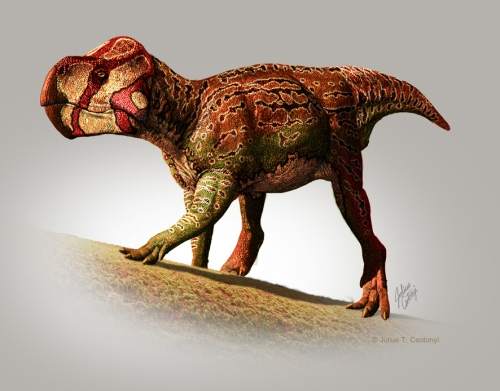Paleontologists have named two new horned dinosaurs based on fossils collected from Alberta, Canada.
The new species, dubbed Unescoceratops koppelhusae and Gryphoceratops morrisoni, respectively, are from the Leptoceratopsidae family of horned dinosaurs. The herbivores are believed to have lived during the Late Cretaceous period approximately 75-83 million years ago.

”These dinosaurs fill important gaps in the evolutionary history of small-bodied horned dinosaurs that lack the large horns and frills of relatives like Triceratops from North America,” explained Michael Ryan, Ph.D., curator of vertebrate paleontology at The Cleveland Museum of Natural History, lead author on the research.
“Although horned dinosaurs originated in Asia, our analysis suggests that leptoceratopsids radiated to North America and diversified here, since the new species, Gryphoceratops, is the earliest record of the group on this continent.”
According to Ryan, Unescoceratops koppelhusae lived approximately 75 million years ago and measured about one to two meters (6.5 feet) in length and weighed less than 91 kilograms (200 pounds). Although the dinosaur had a short frill extending from behind its head, the creature lacked ornamentation on its skull. It had a parrot-like beak, with teeth ower and rounder than those of any other leptoceratopsid. In addition, its hatchet-shaped jaw had a distinct portion of bone that projected below the jaw like a small chin.
Meanwhile, Gryphoceratops morrisoni lived about 83 million years ago and boasted a shorter, deeper jaw shape than any other leptoceratopsid. Based on unique characteristics of the jaw and its size, the researchers believe that Gryphoceratops was an adult that did not exceed one-half meter in length. Meaning, it is likely the smallest adult-sized horned dinosaur in North America – and one of the smallest adult-sized plant-eating dinosaurs known.
“Small-bodied dinosaurs are typically poorly represented in the fossil record, which is why fragmentary remains like these new leptoceratopsids can make a big contribution to our understanding of dinosaur ecology and evolution,” added David Evans, associate curator of vertebrate palaeontology at the Royal Ontario Museum and assistant professor at the University of Toronto.






